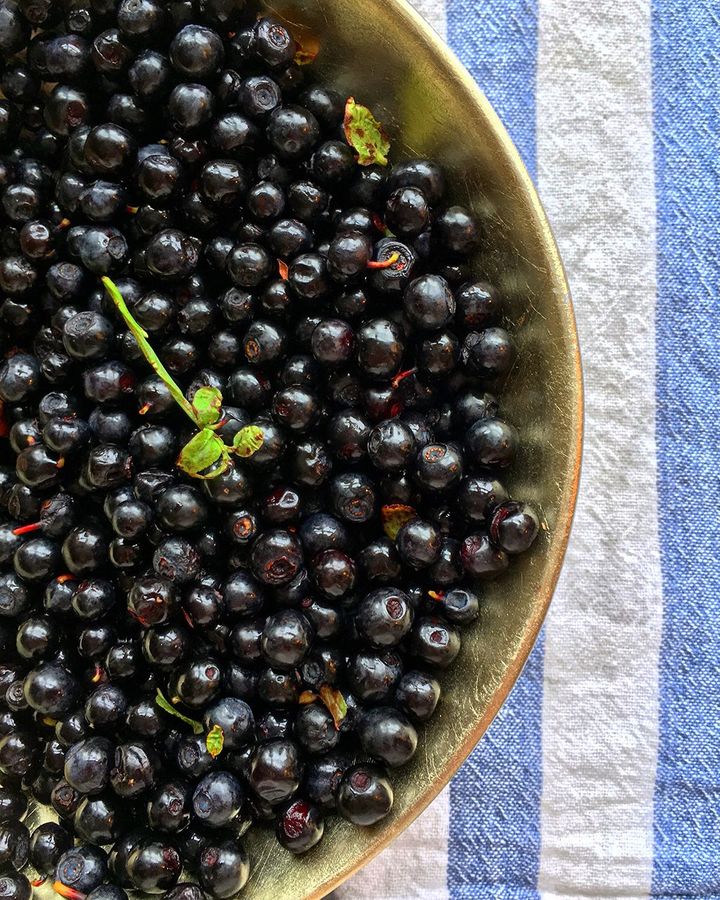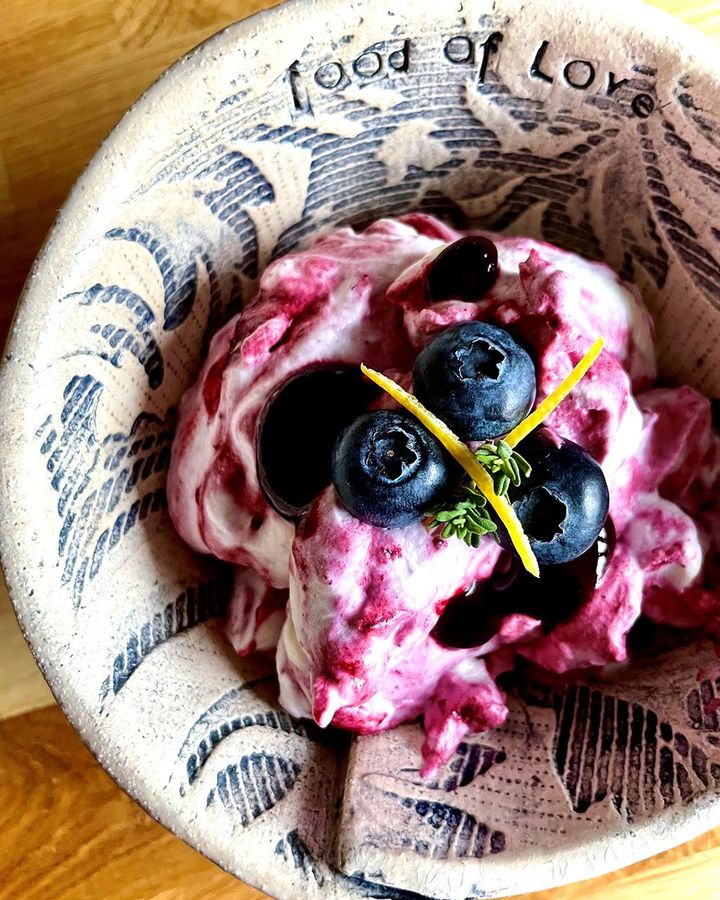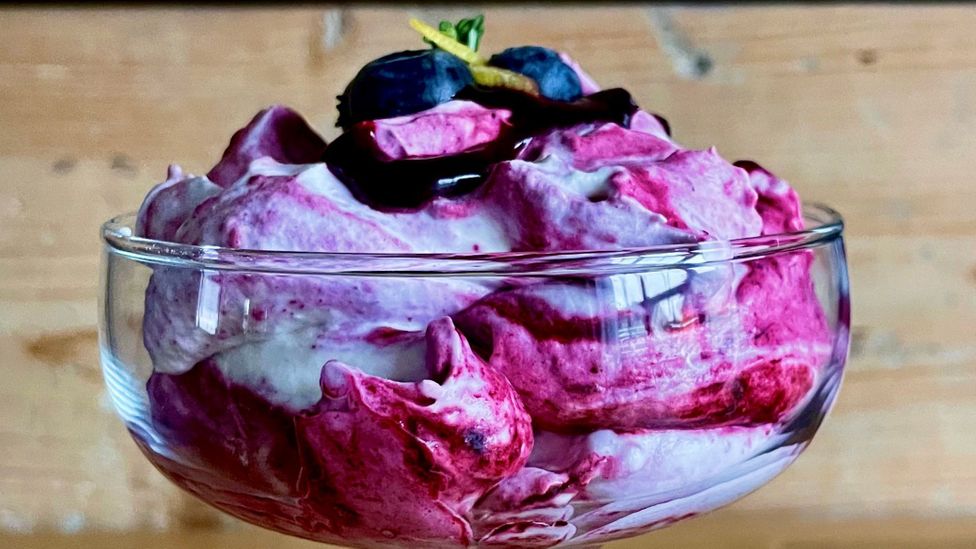Along hedgerows and up Ireland's boggy hillsides grow small, wild berries, sweetened by summer sun and heralding the beginning of harvest. These purple berries are known as fraughans, from the Irish fraochán. Other names include herts (hurts or hursts), bilberry, whortleberry, whimberry or cowberry. They are the wild cousin to the cultivated blueberry, with an intense sweetness and juiciness that belies their diminutive size.
Their peak ripeness coincides with harvest-time celebrations, such as hay making, an important time of feasting and festivals throughout Ireland. On the first Sunday in August, it's customary for local people to descend upon places where fraughans flourish to pick and gorge on as many as they can. This day is known as Fraughan Sunday, also Garland Sunday, and coincides with the old Celtic festival of Lughnasa, one of four important "cross-quarter days" that occur at the midpoint between each solstice and equinox.
Fraughan Sunday used to be celebrated with game playing, courting and eating the wild fraughans growing high up in the mountains. Nowadays, fraughan picking, as well as deciding the best way to eat them all, is the sole focus of the day.
Where fraughans grow, cultivated blueberries seem to flourish best. Despite this, only two commercial blueberry farms operate on the island of Ireland and Derry Duff Farm is one of them. Perched high above the Bantry peninsula in West Cork, the farm is owned and run by Dr Steve Collins and his wife Claire, who bought the land 18 years ago and established an organic blueberry farm.
The Collins', originally from the UK, were unaware of the Irish traditions of Fraughan Sunday or that fraughans were growing in secluded spots on the edge of Derry Duff Farm. Their decision to grow blueberries was based purely on the fact that, at high altitude and with acidic soil, very little else besides blueberries could be grown as a viable crop.

This wild berry is found on the boggy hillsides of Ireland during the peak of summer (credit: Kate Ryan)
"I spent a lot of my holidays in County Kerry, but never came across fraughans over there," said Claire. "I knew nothing until we came here, then, when we started to grow blueberries, people would refer to them. A lot of people have said they remember picking wild fraughans. A friend, a keen gardener, was walking the farm one day and spotted some fraughan bushes growing close to the blueberry fields, nestled into one of the old ancient walls."
The Collins' nearest neighbour, Peggy Cronin, lives on her own farm bordering Derry Duff. In her mid-70s now, she was born and raised in this isolated pocket of West Cork and remembers a much simpler way of life.
"She told us stories of walking to school over the mountains, coming home and harvesting vegetables or digging potatoes for dinner, and sitting to do homework by candlelight – it was a totally different time," said Claire. Cronin fondly remembers picking the fraughans around hay harvesting time. "As children, they'd sneak off with a basin and fill it with berries. It was a great treat," said Claire.
Few berries ever made it back to the house, as the temptation to eat as you picked was too great. Any berries that did make it back were turned into a simple treat with cream and sugar. Many who enjoy foraging for fraughans still like to eat them in this way, as a once-a-year treat during their peak season.
Sadly, there are far fewer fraughan bushes today as hedgerows are removed to make room for more grazing space. It's illegal to clear more than 500m of hedgerows in Ireland without oversight by the Department of Agriculture, Food and the Marine, but significant damage has been done nonetheless, and the hedgerows that remain are not always healthy ecosystems.
As a native shrub, fraughans make perfect hedgerow plants, especially in acidic soil areas where not much else can thrive. Their dense structure creates a perfect habitat for birds, insects and small mammals; the flowers provide fodder for bees; and its fruit is food for wild birds.
As hedgerows are damaged or cleared away, the prospect of the fraughan harvest diminishes with each passing year. The annual festival of Fraughan Sunday is observed in very few places today, and Lughnasa's popularity relies on resurgent interest in old Celtic cross-quarter day festivals.
Back on Derry Duff Farm, the first of 13 varieties of blueberries are ready to crop in the second half of July, with harvest continuing through to October. By contrast, the short fruiting season for fraughans comes and goes in four short weeks – if the birds don't get there first, of course.

Fraughan fool: a berry and cream treat (Credit: Kate Ryan)
Ingredients
150g (a little over 5oz) fraughans or blueberries, plus more for garnish
1 tsp white sugar
juice of half a lemon, plus zest for garnishing
2 large thyme sprigs, plus leaves for garnishing
250ml (8½oz) double cream
Method
Step 1
Put the fraughans or blueberries in a medium saucepan. Add the sugar, lemon juice and thyme sprigs. Cook over low heat for 5-10 minutes until the berries start to break down and thicken but retain some of their shape. Remove the thyme sprigs and set the compote aside to cool.
Step 2
In a medium bowl, whip the cream until it is thick enough to hold its shape when the compote is stirred in; if it's too soft it will collapse. Gently fold half of the cooled compote into the whipped cream to ripple through.
Step 3
Spoon the whipped berry cream into individual servings and drizzle over more compote. Garnish with lemon zest, thyme leaves and extra berries.
BBC.com's World's Table "smashes the kitchen ceiling" by changing the way the world thinks about food, through the past, present and future.
---
Join more than three million BBC Travel fans by liking us on Facebook, or follow us on Twitter and Instagram.
If you liked this story, sign up for the weekly bbc.com features newsletter called "The Essential List". A handpicked selection of stories from BBC Future, Culture, Worklife and Travel, delivered to your inbox every Friday.
